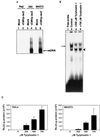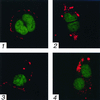Impaired intracellular trafficking of adeno-associated virus type 2 vectors limits efficient transduction of murine fibroblasts
- PMID: 10623762
- PMCID: PMC111620
- DOI: 10.1128/jvi.74.2.992-996.2000
Impaired intracellular trafficking of adeno-associated virus type 2 vectors limits efficient transduction of murine fibroblasts
Abstract
Although adeno-associated virus type 2 (AAV) has gained attention as a potentially useful alternative to the more commonly used retrovirus- and adenovirus-based vectors for human gene therapy, efficient gene transfer and transgene expression by AAV vectors require that the following two obstacles be overcome. First, the target cell must express the receptor and the coreceptor for AAV infection, and second, the cell must allow for viral second-strand DNA synthesis. We now describe a third obstacle, impaired intracellular trafficking of AAV to the nucleus, which results in the lack of transgene expression in murine fibroblasts which do express the AAV receptor and the coreceptor and which are permissive for viral second-strand DNA synthesis. We document that AAV vectors bind efficiently and gain entry successfully into NIH 3T3 cells, but trafficking into the nucleus is significantly impaired in these cells. In contrast, viral trafficking to the nucleus in cells known to be efficiently transduced by AAV vectors is both rapid and efficient. The demonstration of yet another obstacle in AAV-mediated gene transfer has implications for the optimal use of these vectors in human gene therapy.
Figures



Similar articles
-
Adeno-associated virus type 2-mediated gene transfer: altered endocytic processing enhances transduction efficiency in murine fibroblasts.J Virol. 2001 May;75(9):4080-90. doi: 10.1128/JVI.75.9.4080-4090.2001. J Virol. 2001. PMID: 11287557 Free PMC article.
-
Role of cellular FKBP52 protein in intracellular trafficking of recombinant adeno-associated virus 2 vectors.Virology. 2006 Sep 30;353(2):283-93. doi: 10.1016/j.virol.2006.04.042. Epub 2006 Jul 10. Virology. 2006. PMID: 16828834 Free PMC article.
-
Adeno-associated virus type 2-mediated gene transfer: role of cellular T-cell protein tyrosine phosphatase in transgene expression in established cell lines in vitro and transgenic mice in vivo.J Virol. 2003 Feb;77(4):2741-6. doi: 10.1128/jvi.77.4.2741-2746.2003. J Virol. 2003. PMID: 12552015 Free PMC article.
-
Humoral immunity to AAV vectors in gene therapy: challenges and potential solutions.Discov Med. 2013 Jun;15(85):379-89. Discov Med. 2013. PMID: 23819952 Review.
-
Intracellular trafficking and transgene expression of viral and non-viral gene vectors.Adv Drug Deliv Rev. 2001 Nov 19;52(3):153-64. doi: 10.1016/s0169-409x(01)00216-2. Adv Drug Deliv Rev. 2001. PMID: 11718940 Review.
Cited by
-
Enhancing gene delivery of adeno-associated viruses by cell-permeable peptides.Mol Ther Methods Clin Dev. 2014 Feb 19;1:12. doi: 10.1038/mtm.2013.12. eCollection 2014. Mol Ther Methods Clin Dev. 2014. PMID: 26015948 Free PMC article.
-
Liver-Directed Adeno-Associated Viral Gene Therapy for Hemophilia.J Genet Syndr Gene Ther. 2012 Jan 18;1:1-9. doi: 10.4172/2157-7412.S1-009. J Genet Syndr Gene Ther. 2012. PMID: 23565343 Free PMC article.
-
Common gene therapy viral vectors do not efficiently penetrate sputum from cystic fibrosis patients.PLoS One. 2011;6(5):e19919. doi: 10.1371/journal.pone.0019919. Epub 2011 May 27. PLoS One. 2011. PMID: 21637751 Free PMC article.
-
Adeno-associated virus type 2-mediated gene transfer: role of cellular FKBP52 protein in transgene expression.J Virol. 2001 Oct;75(19):8968-76. doi: 10.1128/JVI.75.19.8968-8976.2001. J Virol. 2001. PMID: 11533160 Free PMC article.
-
Adeno-associated virus type 2 capsids with externalized VP1/VP2 trafficking domains are generated prior to passage through the cytoplasm and are maintained until uncoating occurs in the nucleus.J Virol. 2006 Nov;80(22):11040-54. doi: 10.1128/JVI.01056-06. Epub 2006 Sep 6. J Virol. 2006. PMID: 16956943 Free PMC article.
References
-
- Alexander I E, Russell D W, Spence A M, Miller A D. Effects of gamma irradiation on the transduction of dividing and nondividing cells in brain and muscle of rats by recombinant adeno-associated virus vectors. Hum Gene Ther. 1996;7:841–850. - PubMed
-
- Bartlett J S, Samulski R J, McCown T J. Selective and rapid uptake of adeno-associated virus type 2 in brain. Hum Gene Ther. 1998;9:1181–1186. - PubMed
-
- Berns K I, Bohenzky R A. Adeno-associated viruses: an update. Adv Virus Res. 1987;32:243–307. - PubMed
-
- Berns K I, Giraud C. Biology of adeno-associated virus. Curr Top Microbiol Immunol. 1996;218:1–23. - PubMed
-
- Carter B J, Flotte T R. Development of adeno-associated virus vectors for gene therapy of cystic fibrosis. Curr Top Microbiol Immunol. 1996;218:119–144. - PubMed
Publication types
MeSH terms
Substances
Grants and funding
LinkOut - more resources
Full Text Sources
Other Literature Sources

